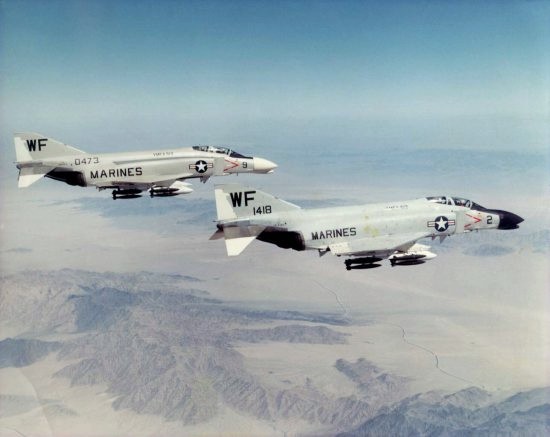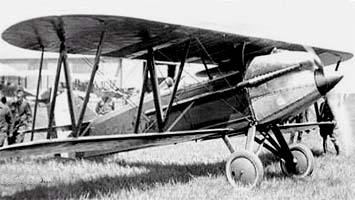|
1924 United States Army Air Service Aircraft Designation System
In 1924, problems with the previous designation system led to a general revamping of the designation system used by the United States Army Air Service. This system was to remain in effect with the U.S. Army Air Corps, the U.S. Army Air Forces and the independent U.S. Air Force, as well as those aircraft remaining in the U.S. Army after 1947. With some minor changes it became the basis of the 1962 United States Tri-Service aircraft designation system. __TOC__ 1924–1962 Designation System The designation given to a particular aircraft can be broken down to provide information about that specific aircraft. A hypothetical example shows a typical designation, and what each section is. Tables below indicate possible codes used for each section, what their meanings were, and the time period in which they were used – not all codes were in use at the same time, and some codes, such as P for pursuit were changed to F for fighter for a given aircraft while they were in servi ... [...More Info...] [...Related Items...] OR: [Wikipedia] [Google] [Baidu] |
1919 United States Army Air Corps Aircraft Designation System
From 1919 until 1924, the United States Army Air Service used a system to designate the types of aircraft it was operating, based on role and specific characteristics of the aircraft. When first instituted, Roman numerals were used to number the designations in use. These numerals were only applied to the first 15 types before being abandoned. Air-cooled engine, Air-cooled and Water cooling, Water-cooled refer to the engines installed, while Pursuit was the name given to fighter aircraft in the United States Army, US Army, at that time. The system was replaced by the 1924 United States Army Air Service aircraft designation system. List of designations Source: BridgesBridges, 2006 References Citations Bibliography * John M. Andrade, ''U.S. Military Aircraft Designations and Serials since 1909'', Midland Counties Publications, England, 1979, * {{US military navbox American military aviation United States Army Air Forces lists Military aircraft designation systems, Unite ... [...More Info...] [...Related Items...] OR: [Wikipedia] [Google] [Baidu] |
United States Army Air Service
The United States Army Air Service (USAAS)Craven and Cate Vol. 1, p. 9 (also known as the ''"Air Service"'', ''"U.S. Air Service"'' and before its legislative establishment in 1920, the ''"Air Service, United States Army"'') was the aerial warfare service component of the United States Army between 1918 and 1926 and a forerunner of the United States Air Force. It was established as an independent but temporary branch of the United States Department of War, U.S. War Department during World War I by two executive orders of President Woodrow Wilson: on May 24, 1918, replacing the Aviation Section, U.S. Signal Corps, Aviation Section, Signal Corps as the nation's air force; and March 19, 1919, establishing a military Director of Air Service to control all aviation activities., p. 149, Appendix 2 Redesignations of the Army Air Arm, 1907–1942. Its life was extended for another year in July 1919, during which time Congress passed the legislation necessary to make it a permanent establ ... [...More Info...] [...Related Items...] OR: [Wikipedia] [Google] [Baidu] |
1962 United States Tri-Service Aircraft Designation System
The Tri-Service aircraft designation system is a unified system introduced in 1962 by the United States Department of Defense for designating all U.S. military aircraft. Previously, the U.S. armed services used United States military aircraft designation systems, separate nomenclature systems. Under the tri-service designation system, officially introduced on 18 September 1962, almost all aircraft receive a unified designation, whether they are operated by the United States Air Force (USAF), United States Navy (USN), United States Marine Corps (USMC), United States Army, United States Space Force (USSF), or United States Coast Guard (USCG). Experimental aircraft operated by manufacturers or by NASA are also often assigned designations from the List of X-planes, X-series of the tri-service system. The 1962 system was based on the one used by the USAF between 1948 and 1962, which was in turn based on the type, model, series 1924 United States Army Air Service aircraft designation ... [...More Info...] [...Related Items...] OR: [Wikipedia] [Google] [Baidu] |
Lockheed P-80
The Lockheed P-80 Shooting Star is the first jet fighter used operationally by the United States Army Air Forces (USAAF) during World War II. Designed and built by Lockheed in 1943 and delivered just 143 days from the start of design, two pre-production models saw limited service in Italy just before the end of World War II. Designed with straight wings, the type saw extensive combat in Korea with the United States Air Force (USAF) as the F-80. America's first successful turbojet-powered combat aircraft, it was soon outclassed with the appearance of the swept-wing transonic MiG-15 and was quickly replaced in the air superiority role by the transonic F-86 Sabre. The F-94 Starfire, an all-weather interceptor using the same airframe, also saw Korean War service. The closely related T-33 Shooting Star trainer remained in service with the U.S. Air Force and Navy well into the 1980s, with the last NT-33 variant not retired until April 1997. Design and development The XP-80 had ... [...More Info...] [...Related Items...] OR: [Wikipedia] [Google] [Baidu] |
Republic P-47 Thunderbolt
The Republic P-47 Thunderbolt is a World War II-era fighter aircraft produced by the American company Republic Aviation from 1941 through 1945. It was a successful high-altitude fighter, and it also served as the foremost American fighter-bomber in the ground-attack role. Its primary armament was eight .50-caliber machine guns, and it could carry 5-inch rockets or a bomb load of . When fully loaded, the P-47 weighed up to 8 tons, making it one of the heaviest fighters of the war. The Thunderbolt was effective as a short-, medium-, and long range escort fighter in high-altitude air-to-air combat and ground attack in both the European and Pacific theaters. The P-47 was designed around the powerful Pratt & Whitney R-2800 Double Wasp 18-cylinder radial engine, which also powered two U.S. Navy/U.S. Marine Corps fighters, the Grumman F6F Hellcat and the Vought F4U Corsair. An advanced turbosupercharger system ensured the aircraft's eventual dominance at high altitudes, while al ... [...More Info...] [...Related Items...] OR: [Wikipedia] [Google] [Baidu] |
Consolidated B-24 Liberator
The Consolidated B-24 Liberator is an American heavy bomber, designed by Consolidated Aircraft of San Diego, California. It was known within the company as the Model 32, and some initial production aircraft were laid down as export models designated as various LB-30s, in the Land Bomber design category. At its inception, the B-24 was a modern design featuring a highly efficient shoulder-mounted, high aspect ratio Davis wing. The wing gave the Liberator a high cruise speed, long Range (aeronautics), range and the ability to carry a heavy Aerial bomb, bomb load. In comparison with its contemporaries, the B-24 was relatively difficult to fly and had poor low-speed performance; it also had a lower Ceiling (aeronautics), ceiling and was less robust than the Boeing B-17 Flying Fortress. While Aircrew#Military, aircrews tended to prefer the B-17, General Staff favored the B-24 and procured it in huge numbers for a wide variety of roles. At approximately 18,500 units – including 8,68 ... [...More Info...] [...Related Items...] OR: [Wikipedia] [Google] [Baidu] |
Stinson Reliant
The Stinson Reliant is a popular single-engine four- to five-seat high-wing monoplane manufactured by the Stinson Aircraft Company, Stinson Aircraft Division of the Aviation Manufacturing Corporation of Wayne, Michigan. Design and development The Reliant is a high-wing, fixed-tailwheel land monoplane powered with a variety of radial engines. 1,327 Reliants of all types were made from 1933 to 1941, in different models, from SR-1 to SR-10. The final commercial model, the Stinson Reliant SR-10, was introduced in 1938. A militarized version was first flown in February 1942 and remained in production through several additional versions (all externally identical) until late 1943 for the US and British armed forces. Reliant production can be broken into two distinct types – the straight-wing Reliants (all models up to SR-6) and the gull-wing Reliants (all models from SR-7 and after, including the militarized V-77/AT-19), with there being little in common between the two groups of ... [...More Info...] [...Related Items...] OR: [Wikipedia] [Google] [Baidu] |
Lists Of Military Aircraft Of The United States
Lists of military aircraft of the United States cover current and former military aircraft of the United States Armed Forces. By designation *List of United States Air Force aircraft designations (1919–1962) *List of United States Navy aircraft designations (pre-1962) * List of United States Army aircraft designations (1956–1962) *List of United States Tri-Service aircraft designations * List of U.S. DoD aircraft designations *List of undesignated military aircraft of the United States Other lists * List of United States bomber aircraft *List of United States military helicopters * List of United States fighter aircraft * List of United States attack aircraft * List of active United States Air Force aircraft *List of active United States military aircraft * List of active United States naval aircraft * List of aircraft of the United States during World War II * List of future military aircraft of the United States * UAVs in the U.S. military * List of U.S. military equipment na ... [...More Info...] [...Related Items...] OR: [Wikipedia] [Google] [Baidu] |
List Of United States Air Force Aircraft Designations (1919–1962)
This list of United States Air Force aircraft designations (1919–1962) includes prototype, pre-production and operational type designations under the 1919 United States Army Air Service aircraft designation system, 1919 and 1924 United States Army Air Service aircraft designation system, 1924 United States Army Air Service aircraft designation systems, which were used by the United States Air Force and its predecessors until the introduction of the unified 1962 United States Tri-Service aircraft designation system, United States Tri-Service aircraft designation system in 1962. For aircraft designations after 1962, see List of United States Tri-Service aircraft designations. For aircraft that did not receive formal designations—including those procured before 1919 when no designation system was in force, and later aircraft that did not receive designations for other reasons—see List of undesignated military aircraft of the United States. Prior to 1919 Prior to 1919, all air ... [...More Info...] [...Related Items...] OR: [Wikipedia] [Google] [Baidu] |
United States Army Air Forces
The United States Army Air Forces (USAAF or AAF) was the major land-based aerial warfare service component of the United States Army and ''de facto'' aerial warfare service branch of the United States during and immediately after World War II (1941–1947). It was created on 20 June 1941 as successor to the previous United States Army Air Corps and is the direct predecessor of the United States Air Force, today one of the six United States Armed Forces, armed forces of the United States. The AAF was a component of the United States Army, which on 2 March 1942 was divided functionally by executive order into three autonomous forces: the Army Ground Forces, the United States Army Services of Supply (which in 1943 became the Army Service Forces), and the Army Air Forces. Each of these forces had a commanding general who reported directly to the Chief of Staff of the United States Army, Army Chief of Staff. The AAF administered all parts of military aviation formerly distributed am ... [...More Info...] [...Related Items...] OR: [Wikipedia] [Google] [Baidu] |







